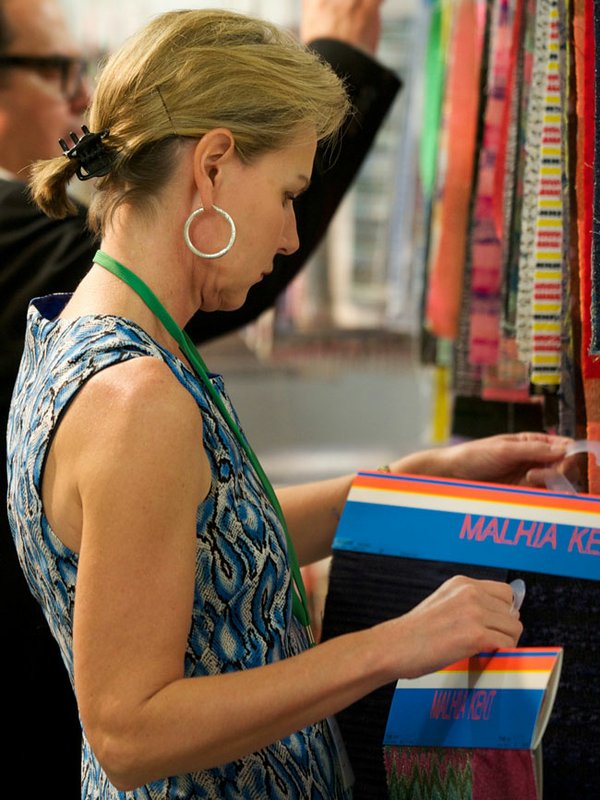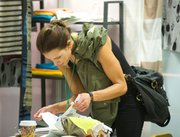TREND SCOUTING: Los Angeles International Textile Show exhibitors reported a strong turnout of designers and fabric buyers with established brands and start-up companies at the recent show.
EMERGING DESIGNERS AND ESTABLISHED BRANDS
Los Angeles International Textile Show
A slow start on opening day of the March 10–12 run of the Los Angeles International Textile Show gave way to a flurry of activity as a mix of established brands and emerging designers turned out to source fabric, trim, trend and technology resources.
Exhibitors showed their collections in showrooms and booths on the 13th floor of the California Market Center, as well as in permanent showrooms on the building’s seventh floor.
After a particularly productive meeting with a Los Angeles manufacturer at the end of the second day, Buhler Quality Yarns Chief Executive Officer Marty Moran said, “That was worth the trip.”
Based in Jefferson, Ga., Buhler was showing in the Lenzing Pavilion, organized by the Austrian fiber producer and maker of Tencel. For yarn makers such as Buhler, the LA Textile show is an opportunity to assist manufacturers find resources and opportunities, particularly in the U.S. and the Western Hemisphere.
“We need an open door for dialogue,” said David Sasso, Buher’s vice president of sales. “There are different opportunities to look at how each supply-chain member can add value and connect with customers so we can jointly price our product together. We can’t do everything [in the U.S.], but we can do luxury fabrics and simple silhouettes.”
But as one customer told Sasso, “It has to look American [-made].”
Buhler was one of the domestic suppliers whose products went into the Polo Ralph Lauren designs worn by U.S. athletes at the recent Winter Olympics games in Sochi, Russia. And towels made with Buhler yarns are being sold at Walmart as part of the giant retailer’s $60 billion made-in-America initiative.
“If you pick the right partners, you can do a lot of things in the United States,” Sasso told the attendees at a sourcing seminar organized by Lenzing during the LA Textile show.
Another panelist, Pat Tabassi, product development and marketing manager at Los Angeles–based millDesign Knit Inc., agreed.
“There’s nothing like sitting down with the customer and building that trust and rapport,” she said. “There are ways to bring the price down and be creative.”
The panel also included Los Angeles–based converter Britannia Mills Ltd. and Lumberton, N.C.–based vertical knit mill Alamac American Knits.
Busy booths
Many exhibitors reported a mix of well-established brands such as Splendid and Karen Kane, as well as newer start-up companies.
Sandrine Bernard, executive vice president of French lace mill Solstiss, said there were many new companies on the first day of the show, but by day two, the traffic included plenty of her existing customers. Her Solstiss colleague Jane Burge noted a high number of companies from San Francisco.
There was constant activity in the Robert Kaufman Fabrics booth, where Sales Manager Ron Kaufman said, “We saw 80 to 100 customers over the last couple of days, including some established people in the denim world we want to work with.”
Dan Sassower of Britannia Mills said the mood was upbeat and traffic good.
“It’s been busy since the get-go,” he said, adding that he was seeing a lot of new potential customers. “They’re open to a lot of new things—especially wool.”
Sassower said some people may have skipped the show to prepare for Los Angeles Fashion Market the following week but added that most of his existing customers prefer to review the line in the company’s showroom in the CMC.
Raj Parikh, manager of Los Angeles–based fabric importer Jay Ann, said traffic picked up on the second day of the show as both existing customers and new companies turned out.
“They want to see what is out there,” he said.
For international exhibitors, the show represents an opportunity to capture West Coast business.
This was the second time at the show for Turkish print mill Confetti Fabrics, said representative Etru al Ankonmaz. The Los Angeles show is the last stop on a trade-show circuit that included Première Vision Preview in New York in January and Première Vision in Paris in February. “This is the last show we have to work,” Ankonmaz said. “Compared to European fashion, it’s late.”
Confetti offers two types of prints—traditional rotary prints and quicker-turn digital prints. The minimum order for rotary prints is 1,000 yards and 200 yards for digital prints.
“We have to be flexible; business is changing,” Ankonmaz said. “Everybody is trying to catch up with the Zara idea.”
Trend spotting
Designers scouting trends at the show had plenty of variety from which to choose.
Design Knit was showing denim-inspired knits, including all shades of blue, as well as true indigo knits, which can be washed like denim. The mill was also showing texture knits, double-face fabrics and lighter weights for activewear.
President Shala Tabassi said the company is offering more activewear fabrics made with natural fibers rather than the traditional synthetic content.
Robert Kaufman Fabrics was also showing denim-inspired fabrics including railroad stripes and chambrays.
“We’re a line that goes great with denim,” Kaufman said.
The company was also showing more printed knits, including cotton/spandex jersey and interlock.
“For the last 20 years, people have been asking us to put our prints on knits,” Kaufman added.
At Lenzing, the newest development is Modal Color, a colorfast version of Lenzing Modal in which the color is added to the fiber.
“Color pigments are fixed in fiber,” said Bernd Schleuchardt, Lenzing project manager for knits. “Itsaves water and energy in the finishing process.”
For Britannia, customers are requesting the company rework traditional mass-market fabrics with luxury yarns, said Britannia President Terrence Chermak.
“For something like a fleece, people are asking for something more upscale, with better fibers, better yarns,” he said, λ























